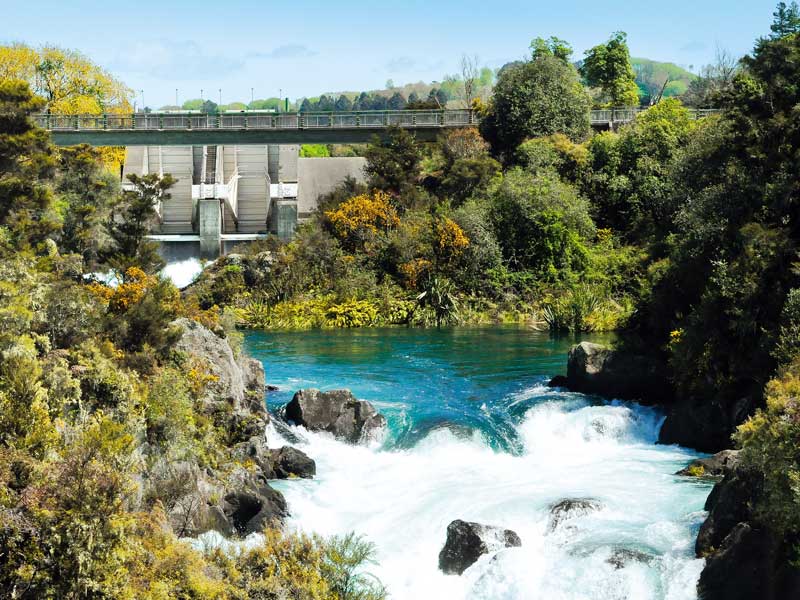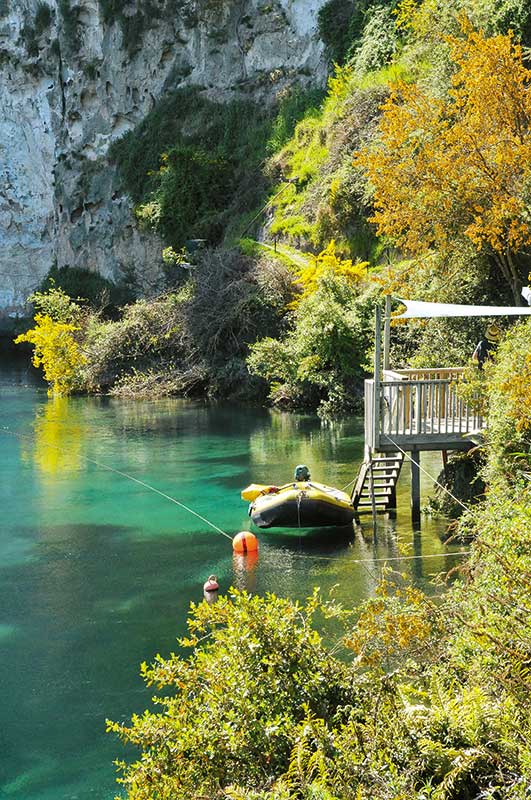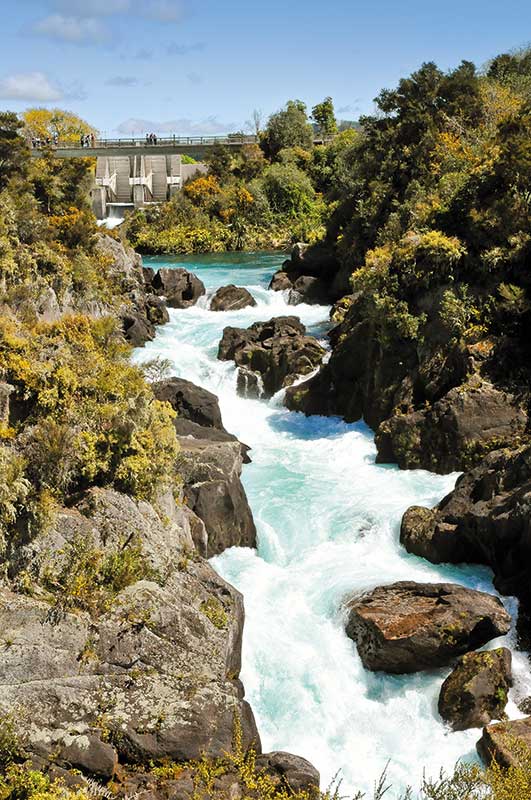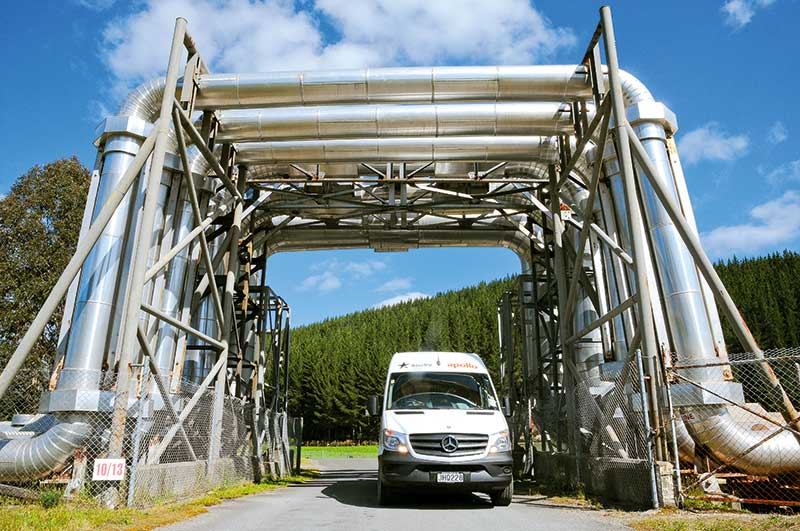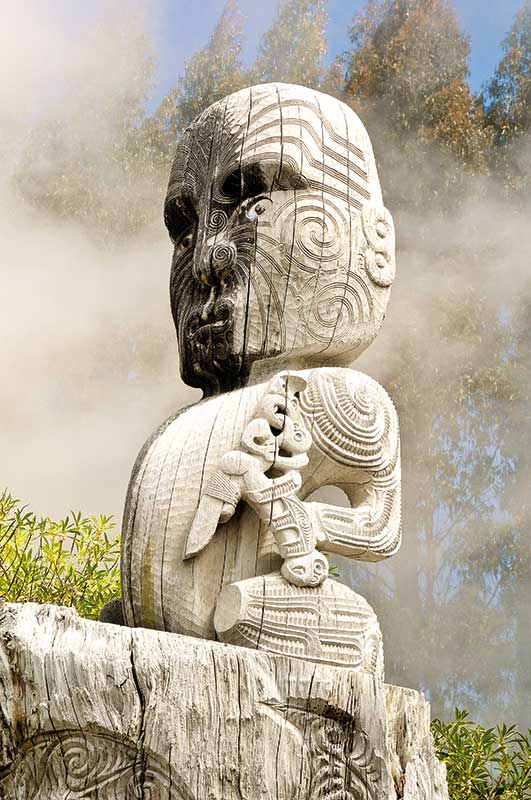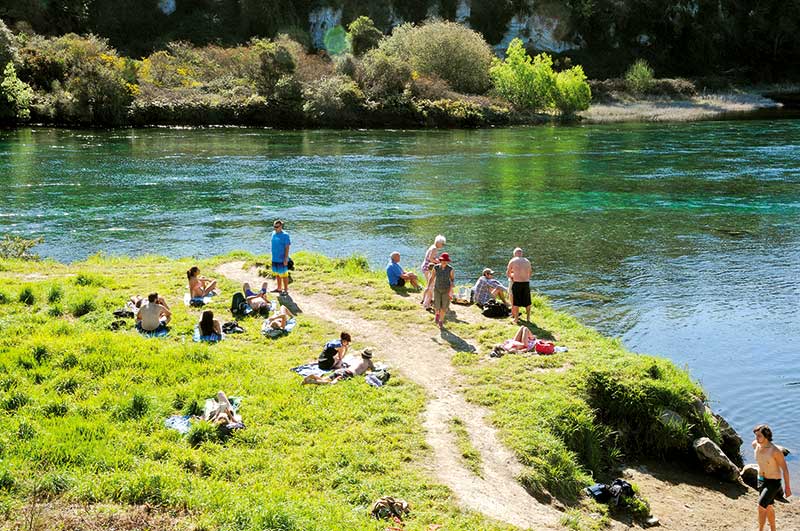The Waikato River leaves Lake Taupo in a languid way, easing through a boat marina and along the edge of a park where people walk their dogs and jog. It heads east for 500 metres then does a horseshoe-shaped loop and in the process, over the 27,000 years it has been taking this course, it has carved out a spectacular, curved cliff.
Pigeons nest in cliff crannies, bushes of golden broom cling on, kowhai trees flower at the base and the river is aqua clear and perfectly pure. It’s a beautiful place to do something crazy.
People from all over the world each pay $170 to bungy jump 47 metres down into the river, from a platform cantilevered from the cliff top. Those who don’t want to bungy can opt for the cheaper $120 extreme swing, a bungy-like contraption in which one sits, rather than hangs, for the big drop.
From a path at the bottom of the cliff I watch people screaming like banshees as they plummet through the air then bounce around on the end of their strings until two pretty girls in with a rubber dingy go and release them and haul them into the dingy.
The river doesn’t care about adrenalin junkies jumping into it and, having made the bend, it meanders in a north easterly direction. Spa Thermal Park, just around the corner from Taupo Bungy, has a kids playground, a BMX course, lots of rolling grassland and, at its north end, a hot thermal stream joins the Waikato River. On this blue day there are plenty of people bathing in the stream’s natural hot pools, plastering their bodies with sulphur-smelling mud, getting massaged under the hot waterfall and then moving just a few metres to the river’s cold water. And back again. Then they lie in the sun on the grassy banks.
This free and natural thermal area marks the beginning of the Taupo to Huka Falls Walkway which follows the east side of the river for two kilometres. It’s a primo walk, an easy path with great views of the river and its edges of willows, ponga and gorse, bright yellow for summer. Riverside rocks smell of sunshine and an occasional trout rises leaving concentric rings on the water’s shiny surface as it disappears under.
Looking at Huka Lodge from across the river is probably as close as I will ever get to it. The gardens are manicured; the lawns are emerald green and perfectly trimmed, reaching to the edge of the river which puts on its beast aqua dress for the passing occasion. The most humble room here is more than $1000 per person, per night, and I bet it’s so refined that you can’t comfortably laugh out loud, or burp after a cold beer on a hot day. I’m happy in the Apollo.
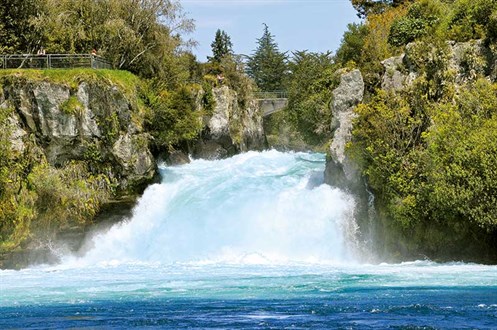
The Waikato River’s next big stunt is Huka Falls. The river, which is normally about 100 metres wide, is squeezed into a chasm just 15 metres across before rushing under a pedestrian bridge and then bursting forth, over an 11 metre ledge, in a thunderous cascade of white water, and into a bubbling caldron below. All is spray and baby rainbows, noise, and the immense power of a mass of fast-moving water. It’s has a watery wow factor and is always worth a look.
Sam is waiting with Apollo in the Huka Falls car park and we zoom north some 12 kilometres to Aratiatia, the first of the eight hydroelectric power generating dams on the river. The dam was built in 1964 above rapids of the same name. The dam, by its nature, holding back water, would have reduced the Aratiatia Rapids to next to nothing. A deal was made that the dam’s gates are opened three times a day (ten, twelve, and two) so that, at these times, the rapids fill to be the raging torrents they once were. One can watch these phenomena from a road bridge by the dam but it’s better to arrive early and walk to one of two viewing platforms below the dam but above the rapids.
The build-up is fun. Sirens warn that the gates are about to open. The little stream in a rocky gorge quickly transforms into a raging torrent with white water furiously bouncing from rock to rock. Then ten minutes later the gates slowly close and the torrent becomes a quiet stream again.
The Aratiatia car park is the kick-off point for the Huka Falls River Cruise, and it is perfectly timed to depart after the closing of the dam’ gates. It seems right and proper, while exploring the beginning of the Waikato River, that we should go on the river not just along the edge of it. The price is right ($37 per person for 90 minutes) so we jump aboard and settle in for a genteel cruise. Dave, the skipper, gives an informative commentary and knows the best places for the boat to poke its nose into along the way.
The Taupo area grows kowhai trees really well and in October these giants are in brilliant gold flower with tui trilling and chiming as they feast on nectar. We see plenty of tui’ action and also paradise ducks with little stripped ducklings hiding in willows and swans with cygnets. Plus, Dave shows us a big old trout hanging in a shallow area next to the river bank.
We also see those courageous people who each paid $115 for a half hour freak-out on Hukafalls Jet. The thrill-seeking jet boat zooms at speed up to a cliff and swerves away at the last second leaving a great trail of splash. It does tight, noisy turns and rockets around at such speeds that the customers’ eyelids would probably turn backwards if they weren’t wearing sunglasses.
Sometimes the boat that one is on is the perfect boat.
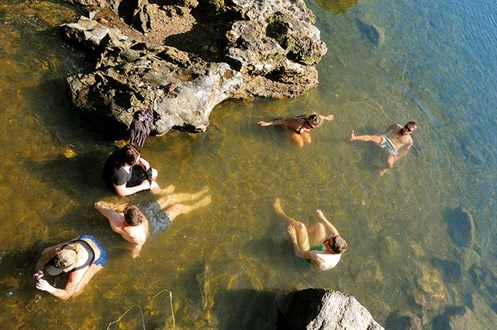
There are still plenty of people noshing a late prawn lunch at Huka Prawn Park, where giant Malaysian prawns breed happily in ponds of river water which is heated to 20 degrees by heat exchangers from the Wairakei Geothermal Power Station. The prawn park is popular with tourists and families. During school holidays the big thing for children is to catch the prawns that they will eat. Prawns aren’t silly and are not easy to catch, but it keeps kids entertained for hours while parents can have a civilised glass, or two, of wine at nearby tables.
Our boat passes under a glamorous new bridge which takes SH1 traffic on a bypass around the back of Taupo. Then we steam up-river to the big event; Huka Falls. This tumbling mass of water looks and feels way more powerful from below than it does from the look-outs. Dave puts the boat as far into the foaming water as the motor will push it. Everyone has a turn on the bow to take a selfie with the roaring water behind them.
After the cruise we take Apollo and ourselves on a tour of the Wairakei Steam Fields, on the west side of the Waikato River. This is a massive industrial complex where geothermal steam is tapped to generate electricity using the steam to drive the turbines. The steam, in two power generating stations, produces 1550 GWh of electrify, annually, which is enough to supply Taupo, Rotorua, Napier and Hamilton. The steam fields, which cover 25 square kilometres, are ugly old pipes to some but, to others including me, they are industrial art.
The road to a lookout goes over massive pipes then under others formed into upside down U-shapes which, Sam explains, allow metal expansion and contraction. There are 54 steam wells, 600 metres deep and very hot steam travels these pipes at 200 kilometres an hour. I enjoy this massive engineering; shiny pipes, stainless steel tanks, gauges and bends and steel infrastructure. And the electricity is useful, too.
Wairakei Terraces hot pools are iwi owned and Maori-themed and are probably the nicest commercial hot pools in New Zealand. But before we soak our tired bodies in the curative, mineral-rich hot water we take a walk around the grounds.
Maori ancestors, Tia and Ngatoroirangi, stand tall amongst the steam and native bush and guard the pools where silica enriched water is brought to the earth’s surface from 1.5 kilometres below. The water is very hot (30 degrees Celcius) and shoots out in a steamy geyser. It is then cooled in two ponds before being cooled some more as it flows over a series of terraces. The terraces are man-made but the silica formations on them are 100 percent natural and reminiscent of the fabled pink and white terraces the Mt Tarawera eruption destroyed 130 years ago.
Unlike the free pools on the river side there is no mud here but three glorious pools of clear steaming water with a delicious turquoise tinge.
Waikato means flowing water, in Maori, and our mighty river is happily flowing nearby. This is a different kind of flowing water and a great way to wrap-up a day.
Read more wonderful articles like this in every issue of Motorhomes Caravans & Destinations magazine. Subscribe here.

